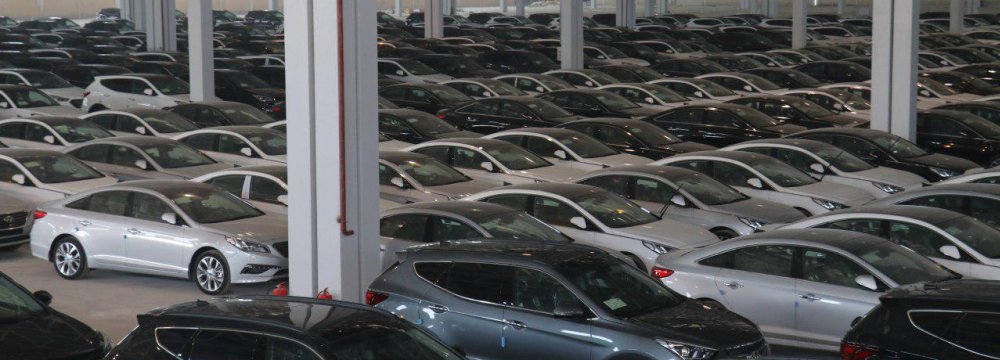
Car Importers in Iran Have a Field Day

The rumor mill has it that the erratic situation is because of unconfirmed reports suggesting that the Ministry of Industries is planning to increase auto import tariffs by up to 100%, local automotive website Asbe Bokhar reported.
The minister, Mohammad Shariatmadari, has often been quoted by local media as saying that “auto import rules will change soon.”
Earlier in November, he said, “The ministry has proposed to the government new guidelines for importing cars.”
However, since his appointment three months ago he has not shared anything with the public nor has said what actually his ministry’s action plan is about returning stability to the imported car market.
Over the weeks, mass media and automotive websites have published several supposedly ‘leaked’ proposals, none of which can be confirmed by Financial Tribune. Almost all of the reports suggest that the import tariffs are to observe whooping increases.
As things stand now, importers pay over 100% of the value of the vehicles to the government and affiliated bodies. Import costs are not limited to tariffs because several government bodies have a share of the lucrative business, in that the importing company or car buyer must pay a variety of extra charges, taxes and other overheads before the vehicle is ready for the road!
For instance, the local Traffic Police department charges importers 10% of the car value when issuing number plates. Furthermore, dealers are required to pay 1% tax to the local Red Crescent -- the money reportedly is used for buying ambulances.
Raw Deal
Avaricious dealers have fleeced Iranian car buyers forever. Imported cars almost always cost twice over and above the prices in international markets. Why? The interpretation is wide open from protecting the dysfunctional local auto industry to running the country on tax revenues instead of oil.
With officialdom keeping the public in the dark, middlemen and greedy brokers have a field day and the people get a raw deal.
The price of the hybrid Hyundai Sonata has risen 210 million rials ($5,250) since August, 10% just in the last week. The car is sold for 1.86 billion rials ($46,500) in Iran. The same South Korean vehicle is offered at less than half this price in the international market, but has few buyers.
Hyundai Tucson has also had a huge jump from 1.86 to 2.1 billion rials ($46,500 to $52,500) in the past three months. Elantra’s price also rose from 1.6 to 1.63 billion rials ($40,000 to $40,750) last week. The model is available in foreign markets for anything between $26,500 to $28,500.
KIA is another popular brand. The Cerato sold for 1.43 billion rials ($35,750) back in August but is now priced at 1.6 billion rials ($40,000).
The price of this car shot up 30 million rials ($750) in less than a week.
The KIA Optima, one of the beautiful luxury sedans, is dearer by 70 million rials ($1,750) and is offered at 2.1 billion rials ($52,500). The same company’s Sportage SUV has also had a huge jump rising from 1.75 to 2 billion rials ($43,750 to $50,000). Both models start at $25,000 in the international market.
Hyundai’s Santa Fe, which is popular with people who can afford expensive cars, has registered the biggest increase in price. It is currently sold for 2.7 billion rials ($67,500) -- up 280 million rials ($7,000) over the past 90 days.


Trump weighs using $2 billion in CHIPS Act funding for critical minerals

Codelco cuts 2025 copper forecast after El Teniente mine collapse

Electra converts debt, launches $30M raise to jumpstart stalled cobalt refinery

Barrick’s Reko Diq in line for $410M ADB backing

Abcourt readies Sleeping Giant mill to pour first gold since 2014

Nevada army depot to serve as base for first US strategic minerals stockpile

SQM boosts lithium supply plans as prices flick higher

Viridis unveils 200Mt initial reserve for Brazil rare earth project

Tailings could meet much of US critical mineral demand – study

Kyrgyzstan kicks off underground gold mining at Kumtor

Kyrgyzstan kicks off underground gold mining at Kumtor

KoBold Metals granted lithium exploration rights in Congo

Freeport Indonesia to wrap up Gresik plant repairs by early September

Energy Fuels soars on Vulcan Elements partnership

Northern Dynasty sticks to proposal in battle to lift Pebble mine veto

Giustra-backed mining firm teams up with informal miners in Colombia

Critical Metals signs agreement to supply rare earth to US government-funded facility

China extends rare earth controls to imported material

Galan Lithium proceeds with $13M financing for Argentina project

Kyrgyzstan kicks off underground gold mining at Kumtor

Freeport Indonesia to wrap up Gresik plant repairs by early September

Energy Fuels soars on Vulcan Elements partnership

Northern Dynasty sticks to proposal in battle to lift Pebble mine veto

Giustra-backed mining firm teams up with informal miners in Colombia

Critical Metals signs agreement to supply rare earth to US government-funded facility

China extends rare earth controls to imported material

Galan Lithium proceeds with $13M financing for Argentina project

Silver price touches $39 as market weighs rate cut outlook

















